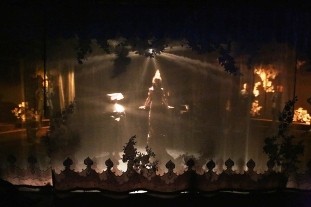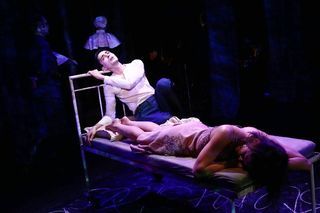|
Back
The Passion According To An Exotic Dancer New York
HERE Mainstage
01/05/2017 - January 6, 7, 11, 12, 13*, 14, 2017
Matt Marks: Mata Hari (World Premiere)
Tina Mitchell (Mata Hari), Mary Mackenzie (Sister Léonide), Jeffrey Gavett (Captain Bouchardon), Daniel Neer (Captain Ladoux), Steve Hrycelak (Rudolf MacLeod, Col. Denvignes), Tomás Cruz (Vadime, Spirit of Norman), Joshua Jeremiah (Col. Von Kalle)
Orchestra: James Moore (Guitar/Banjo), Mila Henry (Piano/Keyboard), Helen Yee (Violin), Kamala Sankaram (Accordion) David Bloom (Conductor)
Paul Peer (Librettist, Director), Neal Wilkinson (Scenic Designer), Lucresia Briceno (Light Designer), David Palmer (Projection Designer), Oana Botez (Costumer Designer), Issac Jones (Sound Engineer), Anabella Lenzu (Choreographer), Aislinn Curry (Stage Manager), PROTOYPE, HERE, Beth Morrison Projects (Producers)

Mata Hari/T. Mitchell (© FamousPeople/Paula Court)
Why hadn’t I heard of PROTOTYPE before? Five years ago, this establishment began presenting new operas in unusual spaces around Manhattan and Brooklyn, and for some reason, I had been ignoring them. Possibly imagining that the experimental productions would be well-meaning, but perhaps inexpert.
Seeing only two of the half-dozen operas this year, I’d better do a few Ave Marias and confess my negligence. For both David Lang’s Anatomy Theater and last night, Matt Marks’ Mata Hari were dramatically and theatrically as stunning as anything of this type I’ve seen in New York.
Not that the quality was unalloyed. Mr. Lang’s Anatomy Theater’s grisly subject of hanging and dismemberment was gripping, but Mr. Lang’s incidental music made it less than operatic, more...well, appropriate trembling and vibratos.
Mr. Mark’s Mata Hari was not only operatic, but the varied musical forms made it inventive and startling. Yes, those operatic pop-dance interpolation have been done before, from Lulu through John Harbison’s Great Gatsby. But taking the story of the original “exotic dancer”, who actually learned her trade in the Dutch East Indies, and making a third of the 90-minute production actually dancing, gave it a twist which looked fantastic on stage.
On the other hand, the drama–and the middle-class Dutch lady who became a voluptuous lady who enticed every military side in World War I (as well as Giocamo Puccini)–was never really dramatic. Librettist Paul Peers did his research all too well. Yet Mata Hari (her Malay/Indonesian name) covered far too many bases, had too many lovers, moved in too many countries for one to really pin her down.
Thus, no matter how brilliantly this was staged, one was not stirred as she went from German to French to Russian lovers, all in the same military garb. The choreography was sweet, as she danced around bed and (simulated) ballroom, the music was often as exciting as the dance, but one began to be confused by the captains and prosecutors.

N. Wilkinson’s set (© Paula Court)
Still, like Mr. Lang’s opera (also staged by the librettist), Mr. Peer’s management of the drama was faultless. Just as the various coverings of Mata Hari were taken off, so the endless curtains on the stage of HERE Theater were pulled and pushed: a flowery scrim curtain over the stage, a half-dozen smaller curtains at the back, inner curtains, outer curtains…It worked, but the mechanism started to seem all too mechanical.
Still, one rarely saw a more dramatic opening, as Mata Hari–acted as well as sung with infinite variations by Tina Mitchell–starts as an Indonesian goddess in an Indonesian story, and her costume is slowly pulled apart by her soon-to-be lovers, until she stands plainly, in a plain prison (the prison walls videoed onto the curtains), and her story begins to be told to the profane cigarette-smoking nun in her cell.
Another curtain rises on the orchestra–four musicians with massive sounds–as well as the suitors who come from the foreground. The music, conservatively, not memorably modern for the arias, goes into a series of tangos, and the actors dance accordingly. Mata Hari with her military wooers, the male wooers dancing with each other, Anabella Lenzu’s choreography in perfect pacing with the intensity of the story.

T. Cruz, T. Mitchell (© Paula Court)
In real life, Mata Hari had only one love, a Russian soldier, here played by pop-jazz singer Tomás Cruz. Also in history, he was Mata Hari’s Judas, deserting her, giving her away to the French prosecutors. This should be a dramatic moment, but here it becomes–while musically powerful–still another vignette in an opera filled with cameos.
Bringing it together is the chorus of lovers, who become a Greek chorus at times, Mr. Marks’ music half-Renaissance, half modern, a sort of half-baked Penderecki. But it still works. One feels at the start and at times during the opera, that sense of both the holy and the profane.
And what does one think about Mata Hari at the climax? Difficult to tell. A photo of the real dancer (with her child, soon to die of syphilis) appears once on the scrim curtain. But Ms. Mitchell, brilliant as she is, speaks with the petulant tone of a Mary Poppins. She may have been the ultimate voluptuary in her early life. In prison, she is a Dutch housewife, irritably complaining about her living conditions.
Not that this detracts from the mammoth undertaking here. Mary Mackenzie as the nun is human, nasty, sympathetic, a real person. The lovers are military, cold, they show their ardor through mechanical dancing rather than passion. Yet, Mata Hari becomes sometimes tiresome. She is a courtesan but no Camille, a prostitute but not a Lulu, she is an ordinary woman who had once been a sybaritic star. That does not make for grand opera. But this production, if not transfixing, had its grand literally moving moments.
Harry Rolnick
|